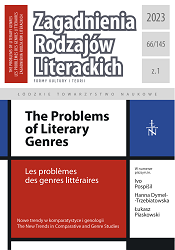Kiedy odchodzi przyjaciel… Jak możliwa jest nie-ludzka biografia?
When a Friend Leaves… How is a Non-Human Biography Possible?
Author(s): Andrzej JuchniewiczSubject(s): Studies of Literature, Sociology, Theory of Literature, Sociology of Literature
Published by: Łódzkie Towarzystwo Naukowe
Keywords: animal death; the companion species; farewell; euthanasia; mourning;
Summary/Abstract: The essay’s author considers the possibility of distinguishing the form of non-human biography (zoobiography) in contemporary literature. In the first part of the essay, the author reconstructs four paths researchers have followed so far in animal studies. In the following parts, however, he addresses the problem of the biography of companion animals as a form increasingly popular at a specific historical moment, characterized by a change in the treatment of non-human characters. Currently, animals cease to play the role of slaves and subordinates. In many narratives, their status is similar to that of children. They deserve care and attention because they are full members of families. The author’s intention of the essay was not so much to codify the rules of the model biography of the animal but to see several possible variants of its implementation. The increased knowledge about the dangers to which companion animals are exposed and health prevention causes people to remodel their relationship with animals. The moment of illness and later death turns out to be crucial to emphasize the importance of the encounter with non-human existence and the impact it has had on the person. The essay’s author noticed many narratives, the characters of which are companion animals. These narratives are prompted by moments of crisis (long-term illness or dying), but writers rarely give up on placing themselves in a projected story about the fate of an animal. The reflections undertaken in the analyzed narratives can be described as temporary (related to the death or illness of an animal) and leaning into the future (they concern the moment of losing one’s own health and fitness). Zoobiographies have multiple functions: they give animals immortality, relate the last stage of their lives and force writers to settle accounts with a being that passes (noting mistakes, abuses, and moments of happiness). The contemporary phenomenon of zoobiography will be associated with linguistic, moral and social changes. The imperative influences their popularity to immortalize companion animals. Their lives are worth commemorating, as are human family members. The practice of creating a zoobiography allows you to trace the individual characteristics of animals, their predispositions, advantages and disadvantages that make them individual, distinguishable, and unique beings.
Journal: Zagadnienia Rodzajów Literackich
- Issue Year: 66/2023
- Issue No: 1
- Page Range: 283-295
- Page Count: 13
- Language: Polish

